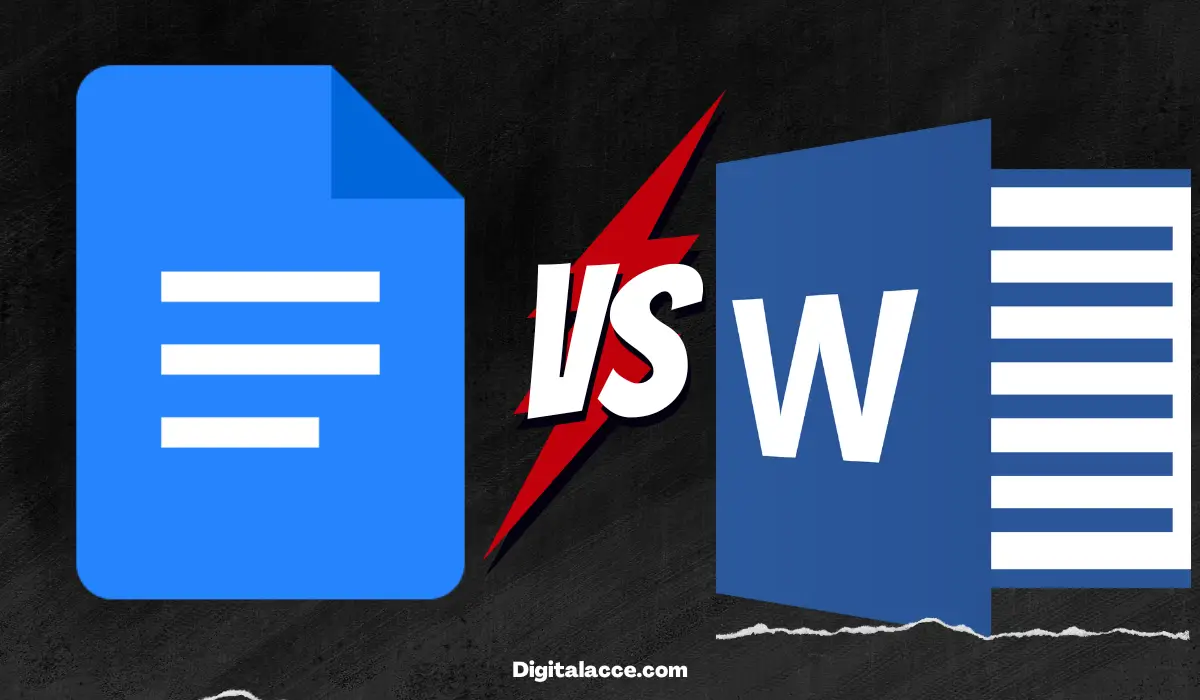Word processing tools have become indispensable in today’s digital age, revolutionizing the way we create, edit, and share documents. Whether it’s drafting a business proposal, crafting an academic essay, Blog post or collaborating on a project, having a reliable word processing tool is crucial for efficiency and productivity. Therefore, the usual comparison of Google Docs vs Microsoft Word comes to mind.
In this digital battleground, two heavyweight contenders have emerged: Google Docs and Microsoft Word. Both platforms offer powerful word-processing capabilities and have a large user base. However, choosing between them can be a daunting task, as each tool possesses its own unique strengths and features.
This article aims to delve into the world of word processing and conduct a comprehensive comparison between Google Docs and Microsoft Word. By exploring their respective strengths, I will provide valuable insights that will help you make an informed decision when selecting the most suitable tool for their specific needs.
Throughout this article, I will evaluate various aspects of these tools, including user interface, collaboration and sharing capabilities, formatting and styling options, advanced features and integrations, compatibility and file management, as well as pricing and licensing.
Additionally, we will incorporate relevant comparative statistics to enhance the accuracy and relevance of this comparison.
Whether you’re a student, a professional, or an avid writer, understanding the differences between Google Docs vs Microsoft Word can significantly impact your productivity and workflow.
So, let’s dive into the world of word processing and embark on this journey to discover which powerhouses reign supreme in digital documents.
Contents
- Summary of Google Docs vs Microsoft Word Comparison
- Google Docs vs Microsoft Word: User Interface and Accessibility
- Google Docs vs Microsoft Word: Collaboration and Sharing Capabilities
- Google Docs vs Microsoft Word: Formatting and Styling
- Google Docs vs Microsoft Word: Advanced Features and Integration
- Google Docs vs Microsoft Word: Compatibility and File Management
- Google Docs vs Microsoft Word: Pricing and Licensing
- Final Thought
Summary of Google Docs vs Microsoft Word Comparison
Here is a brief summary of the comparison between Google Docs and Microsoft Word:
| Comparison Factors | Google Docs | Microsoft Word |
|---|---|---|
| User Interface | Simple, intuitive interface | Familiar interface with extensive features |
| Accessibility | Cross-platform availability | Robust mobile compatibility |
| Collaboration | Real-time editing and commenting | Simultaneous collaboration and chat options |
| Formatting and Styling | Basic formatting options | Extensive formatting and styling features |
| Advanced Features | Grammar and spell-check | Track changes and advanced editing tools |
| Integration | Seamless integration with Google apps | Wide range of third-party integrations |
| Compatibility | Supports various file formats | Excellent compatibility with different formats |
| File Management | Cloud-based storage with version control | Cloud storage with OneDrive integration |
| Pricing and Licensing | Free for all users | Subscription-based pricing model |
Note: This table provides a concise overview of the key points of comparison. For more detailed information, refer to the respective sections in the article below.
Google Docs vs Microsoft Word: User Interface and Accessibility
Google Docs offers an intuitive, user-friendly interface with a clean, minimalist design. Its organized toolbar and menu options make navigation and tool location easy.
The platform is web-based, accessible through any browser on various operating systems. Users can work seamlessly across devices, including desktops, laptops, and tablets.
In contrast, Microsoft Word provides a familiar interface with comprehensive features. Its robust toolbar and ribbon layout offer quick access to formatting and editing options.
While primarily a desktop application for Windows and macOS, Microsoft also offers mobile apps for Android and iOS devices.
Both Google Docs and Microsoft Word integrate with cloud storage services. Google Docs seamlessly integrates with Google Drive, allowing for easy document storage, access, and sharing.
Similarly, Microsoft Word integrates with OneDrive, providing synchronization and accessibility across devices.
Users can choose the word processing tool that best suits their needs and preferences by considering the user interface simplicity, cross-platform availability, mobile compatibility, and cloud storage integration.
Google Docs vs Microsoft Word: Collaboration and Sharing Capabilities
Google Docs excels in real-time collaboration, allowing multiple users to work simultaneously, make edits, add comments, and chat within the document.
It offers easy sharing options with specific access permissions and collaboration with non-users through shareable links.
Microsoft Word also supports collaboration, but real-time updates may require manual saving and refreshing. It provides commenting features and sharing options with different permissions.
Collaboration with non-users is possible through web versions or shared document links.
Comparative statistics on user satisfaction ratings can provide valuable insights into the effectiveness of collaboration features.
Considering these capabilities, Google Docs offers seamless real-time collaboration, while Microsoft Word focuses on sharing permissions and commenting. Choose the tool that aligns best with your collaboration needs.
Google Docs vs Microsoft Word: Formatting and Styling
When comparing Google Docs and Microsoft Word in terms of formatting and styling capabilities, it’s important to consider the available options for customizing the appearance of your documents.
Google Docs provides basic formatting options to help you style your documents. You can easily adjust font styles, sizes, alignment, and spacing to enhance your content’s readability and visual appeal.
While the range of formatting options may be more limited than Microsoft Word, Google Docs offers a clean and streamlined approach to document styling.
On the other hand, Microsoft Word offers extensive formatting and styling features. In addition to the basic formatting options, Word provides a wide range of advanced styling tools.
You can choose from a variety of pre-designed templates and themes to give your documents a professional and polished look. Word also allows for creating custom styles, enabling you to maintain consistent formatting throughout your document.
When it comes to comparative statistics, the number of available templates can give you an idea of the design options offered by each platform. Additionally, user satisfaction ratings on formatting options can provide insights into the ease of use and effectiveness of the styling features.
Ultimately, the choice between Google Docs and Microsoft Word for formatting and styling depends on your specific needs. Microsoft Word may be preferred if you require more advanced styling options and a wide range of templates.
However, if you prefer a simple and streamlined approach to document styling, Google Docs can effectively fulfil your basic formatting requirements.
Read Also: Should I Buy Grammarly Premium?
Google Docs vs Microsoft Word: Advanced Features and Integration
When it comes to advanced features and integration, both Google Docs and Microsoft Word offer powerful tools to enhance your document editing experience.
In Google Docs, you have access to handy advanced editing tools like grammar and spell-check, ensuring error-free documents. Additionally, the word count feature helps you track document length.
Microsoft Word goes a step further with comprehensive, advanced editing features. Track changes allow you to monitor modifications made to your document, making it ideal for collaboration. The word count tool provides insights into document length.
Integration is also important. Google Docs seamlessly integrates with other Google Workspace apps, facilitating collaboration and document sharing. Microsoft Word integrates various third-party apps, plugins, and add-ons, allowing for customizing and extending functionality.
Comparative statistics on the number of integrated apps/plugins can provide insights into the available options.
Choosing between Google Docs and Microsoft Word for advanced features and integration depends on your specific needs. Google Docs offers a straightforward set of tools with seamless integration, while Microsoft Word provides a wider range of integration options and advanced editing features like track changes.
Google Docs vs Microsoft Word: Compatibility and File Management
Both Google Docs and Microsoft Word prioritize file format compatibility to ensure seamless collaboration and sharing.
Google Docs supports import and export options for various file formats, including Microsoft Word (.docx), OpenDocument Text (.odt), and plain text (.txt). It also allows users to import PDFs, preserving the original formatting to some extent.
When exporting documents from Google Docs, users can choose from multiple file formats, ensuring compatibility with different word processors.
Similarly, Microsoft Word supports importing and exporting documents in various formats, including its native .docx format, PDF, plain text, and OpenDocument Text.
This broad compatibility allows users to work with documents created in different word processors and ensures the smooth exchange of files.
File management capabilities: version control, recovery options, and storage flexibility
Both Google Docs and Microsoft Word offer robust file management features to help users organize, track changes, and recover documents.
Google Docs provides automatic version control, allowing users to view and revert to earlier versions of a document. This feature helps in tracking changes and collaborating effectively.
Regarding recovery options, Google Docs includes an “Undo” function for immediate changes and offers an extensive revision history that enables users to restore previous document states.
Google Drive, the cloud storage service integrated with Google Docs, provides flexible storage options and synchronization across devices.
Similarly, Microsoft Word offers version control capabilities, enabling users to track changes and revert to earlier versions of a document.
The “Track Changes” feature allows for collaborative editing with clear visibility of modifications. Microsoft Word also provides an “Undo” function for immediate changes and includes an extensive “Document Recovery” feature to restore unsaved or previously closed documents.
Users can store and access their files through Microsoft’s cloud storage service, OneDrive, which offers flexible storage plans and synchronization across devices.
By considering file format compatibility and evaluating the file management capabilities of Google Docs and Microsoft Word, users can choose the tool that best aligns with their collaboration needs and file management preferences.
Google Docs vs Microsoft Word: Pricing and Licensing
Pricing and licensing are important factors to consider when choosing a word-processing tool. Let’s compare the pricing models and licensing details of Google Docs and Microsoft Word.
Google Docs offers a unique advantage with its pricing model. It is available for free to all users with a Google account. Yes, you read that right; it’s completely free, like WordPress! This makes it an attractive option for individuals, students, and businesses looking to save on software expenses.
On the other hand, Microsoft Word operates on a subscription-based pricing model. It is part of the Microsoft 365 suite, which offers various subscription options. The cost varies depending on the plan and features you choose. For personal use, plans start at around $69.99 per year. Business plans are available at different price points, offering additional collaboration and productivity tools.
Regarding licensing, Google Docs does not require a separate license as it is a web-based application accessible through a Google account. This makes it easy for individuals and businesses to get started without worrying about complex licensing agreements.
Microsoft Word, as part of the Microsoft 365 suite, requires a valid license for use. Different licensing options are available depending on your usage requirements, such as personal use, commercial use, or educational licenses.
Consider your budget and licensing needs when making a decision between Google Docs and Microsoft Word. Google Docs provides a cost-effective solution with its free availability, while Microsoft Word offers a range of subscription plans tailored to different user types and needs.
Ultimately, the choice between Google Docs and Microsoft Word for pricing and licensing depends on your budget, usage requirements, and preference for free vs. subscription-based models.
Final Thought
Both Google Docs and Microsoft Word offer powerful word-processing tools with unique strengths.
To make a choice between Google Docs and Microsoft Word, consider your specific needs and preferences.
If simplicity, collaboration, and cost-efficiency are paramount, Google Docs is the way to go. For those requiring advanced features, extensive formatting options, and compatibility with Microsoft’s ecosystem, Microsoft Word is recommended.
Ultimately, the decision boils down to personal preferences, requirements, and the intended use of the word processing tool. Evaluate your priorities and consider the features, pricing, licensing, and compatibility that align with your needs.
Regardless of your choice, Google Docs and Microsoft Word can facilitate efficient document creation, editing, and collaboration.


